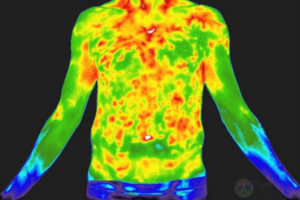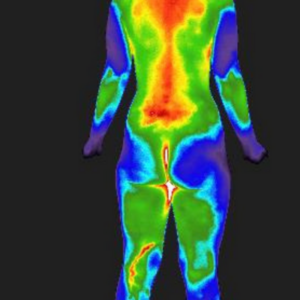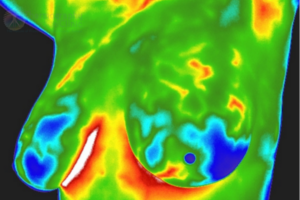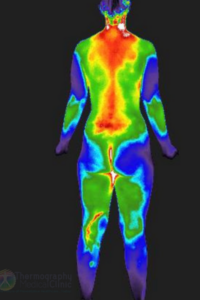Our Services
Thermography offers a non-invasive way to identify and assess areas of inflammation throughout the body. There is now a consensus that chronic inflammation is a clinical marker for a compromised immune system and the onset of chronic disease – even as the initial inflammatory condition may be asymptomatic for an extended period of time. Areas of inflammation present with higher temperatures and are clearly identified from the thermal maps, or thermograms, generated by thermography imaging.
For an overview on the unique contribution of thermography, please read our brief note on the Big Picture on Thermography.
As the human body is one large inter-related system, and as the inflammatory markers associated with specific conditions can manifest in different areas of the body and be associated with different symptoms, there is often substantial value-added from analyzing the wider set of information available from more comprehensive thermography studies. For this reason, it is generally indicated that a full-body study, or at least an upper body study, is preferable over studies which covers only a specific region (such as the breast or the cranial study). The additional understanding, including correlation of different manifestations of inflammatory markets, is often valuable for practitioners in devising an individualized treatment approach. Every person deserves the truth about their state of health.
Find out if you have inflammation before it becomes a chronic condition:
Baseline Study
» visualizes current state of health and prioritizes areas of concern.
Follow-up Studies
» monitor progress towards optimal health and wellness.
Preparing for your Imaging Appointment
SPECIAL INSTRUCTIONS FOR YOUR IMAGING:
» Test Results: If you have copies of related test results (e.g. mammograms, ultrasounds, biopsies) please bring them with you
» Privacy Screening: You will be partially or fully disrobed (depending on the type of study) for purposes of both imaging and to allow for the body temperature to equilibrate with room temperature. Imaging is conducted in a private examination room and you will be imaged behind a privacy screen
» Appointment Duration: The time necessary to complete your imaging is 20-30 minutes for breast thermography, 35-45 minutes for an upper body thermography, and 45-50 minutes for a full body thermography
PREPARING FOR YOUR IMAGING:
» No Prolonged Sun Exposure: Please refrain from prolonged exposures (especially sunburns) within 5 days prior to imaging
» Limit Skin Irritation Activities: We recommend shaving facial hair 2 days prior to imaging
» No Physical Therapy Treatment 24 Hours Prior: This includes chiropractic, acupuncture, massage, electrical muscle stimulation, ultrasound, hot or cold pack use, and others.
DAY OF IMAGING
» No Use of Lotions, Creams, Powders or Make-Up on the day of imaging
» No Use of Deodorants or Anti-perspirants on the day of imaging
» No Shaving on the day of imaging
» No Hot shower Within 4 Hours Prior to imaging
» No Exercise 4 hours Prior to imaging
» Do Not Wear Restrictive Clothing to imaging
» No Gum Chewing on the day of imaging
» No Warm or Cold Beverages Within 2 Hours Prior to imaging, and no alcohol consumption within 12 hours prior to imaging
» We Recommend Nursing as far from 1 Hour Before Imaging as Possible. Breast imaging is safe to have during pregnancy or when nursing
Full Body Study ($365)
» The Upper Body Study consists of thirty-seven (37) images covering the entire body. Imaging normally takes 1 hour. Thermography helps to identify inflammatory, neovascular and neurological phenomena based on levels of temperature, differences in temperature, and appearance and location of thermal patterns.
» Inflammation is a vital part of the immune system’s response to injury and infection. It is the body’s way of signaling the immune system to heal and repair damaged tissue, as well as defend itself against foreign invaders, such as viruses and bacteria. Without inflammation as a physiological response, wounds would fester, and infections could become deadly.
» However, if the inflammatory process goes on for too long or if the inflammatory response occurs in places where it is not needed, it can become problematic. Unlike acute inflammation, chronic inflammation can have long-term and whole-body effects. Chronic inflammation is also called persistent, low-grade inflammation because it produces a steady, low-level of inflammation throughout the body. This type of systemic inflammation can contribute to the development of disease, according to a summary in the Johns Hopkins Health Review.
» With thermographic imaging, we can identify areas of suspected inflammation and infection because they present with heat. Once an area of concern is identified, recommendations for specific follow-up tests and/or examinations become an important part of the thermography report. In addition, many dietary, lifestyle and environmental factors have been shown to play a part in the inflammatory process. It is always important to discuss your thermography report with a regulated practitioner.
Upper Body Health Study ($295)
» The Upper Body Study consists of twenty-one (21) images covering the head and neck, breast, chest, upper back, abdomen and lower back. Imaging normally takes ¾ hour. Thermography helps to identify inflammatory, neovascular and neurological phenomena based on levels of, and differences in, temperature as well as thermal patterns.
» In upper body studies, for example, thermography has been shown to be an effective tool for assessing the functional status of the back—from the cervical to lumbar regions. This includes correlating thermal patterns with trigger points, and dermatomal and scleratomal patterns. Each of these has its own unique map of referral patterns which are used when interpreting a thermogram. By seeing what the human eye cannot see, thermography can assist the clinician in locating the optimal treatment areas. Each has its own unique map of referral patterns which is used to identify the source of the pain, even in the case of referred pain.
» With thermographic imaging, we can identify areas of suspected inflammation and infection because they present with heat. Once an area of concern is identified, recommendations for specific follow-up tests and/or examinations become an important part of the thermography report. In addition, many dietary, lifestyle and environmental factors have been shown to play a part in the inflammatory process. It is always important to discuss your thermography report with a regulated practitioner.
Breast Thermography ($215)
» The Breast Study consists of nine (9) images covering the breast, chest and upper back area. Imaging normally takes no more than ½ hour. As with other parts of the body, thermography helps to identify inflammatory, neovascular and neurological phenomena based on levels of, and differences in, temperature as well as thermal patterns. A thermography study can help to identify abnormal vascular patterns which are associated with the development of chronic disease in the breast region, and it can also aid in monitoring the structural integrity of implants.
» As an additional test, thermography has been shown in peer-reviewed research articles to increase the effectiveness of screening procedures when multiple tests, including thermography, are used to monitor breast health. This is consistent, of course, with the unique information provided by thermography on the body’s physiological and metabolic processes.
» In the area of the breast, thermography can aid in the detection of the following potential conditions:
-
-
-
- Breast cysts
- Lymphatic congestion
- Estrogen dominance
- Generalized inflammation
- Fibrocystic breasts
- Hormone imbalances
-
-
» With thermographic imaging, we can identify areas of suspected inflammation and infection because they present with heat. Once an area of concern is identified, recommendations for specific follow-up tests and/or examinations become an important part of the thermography report. In addition, many dietary, lifestyle and environmental factors have been shown to play a part in the inflammatory process. It is always important to discuss your thermography report with a regulated practitioner.




